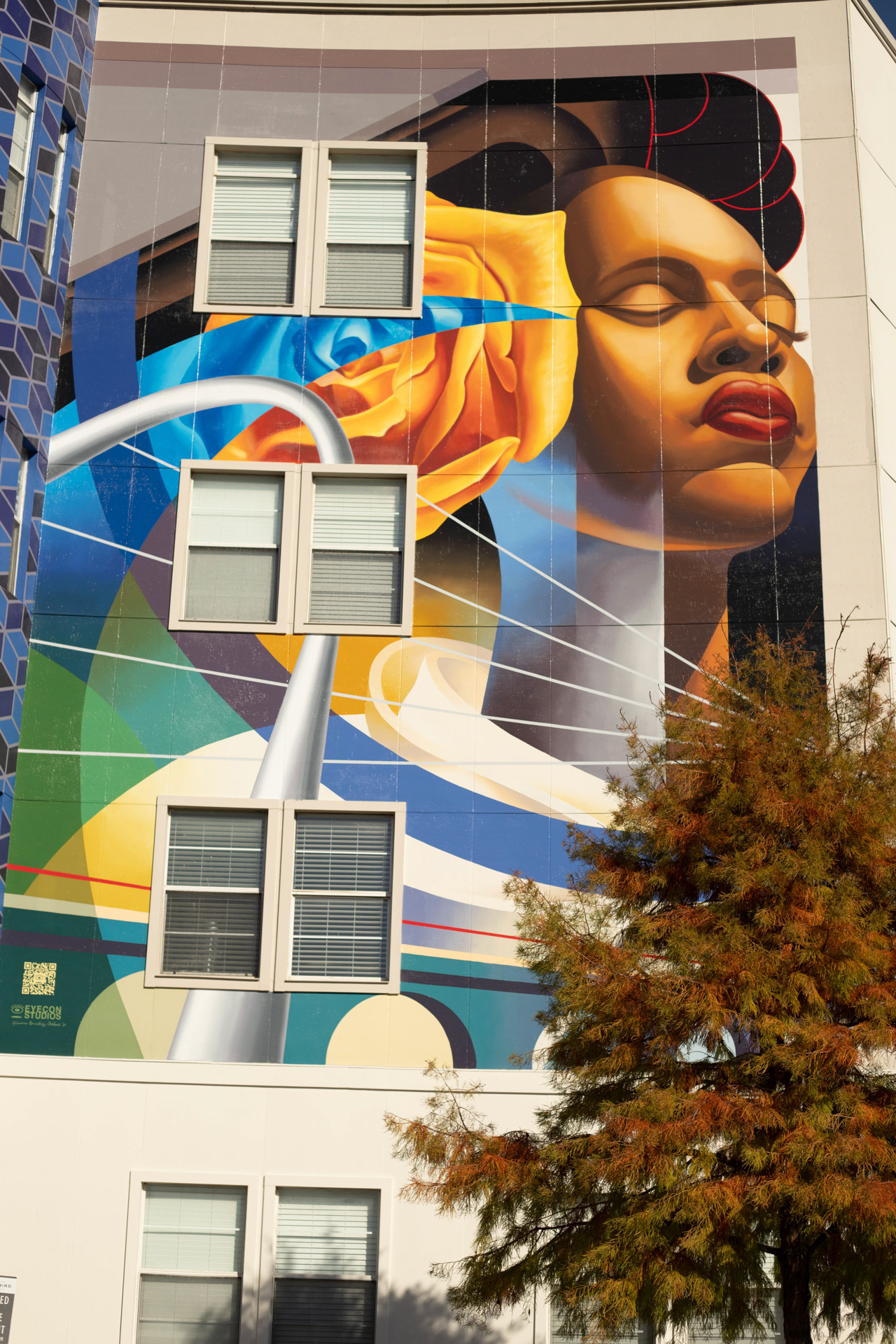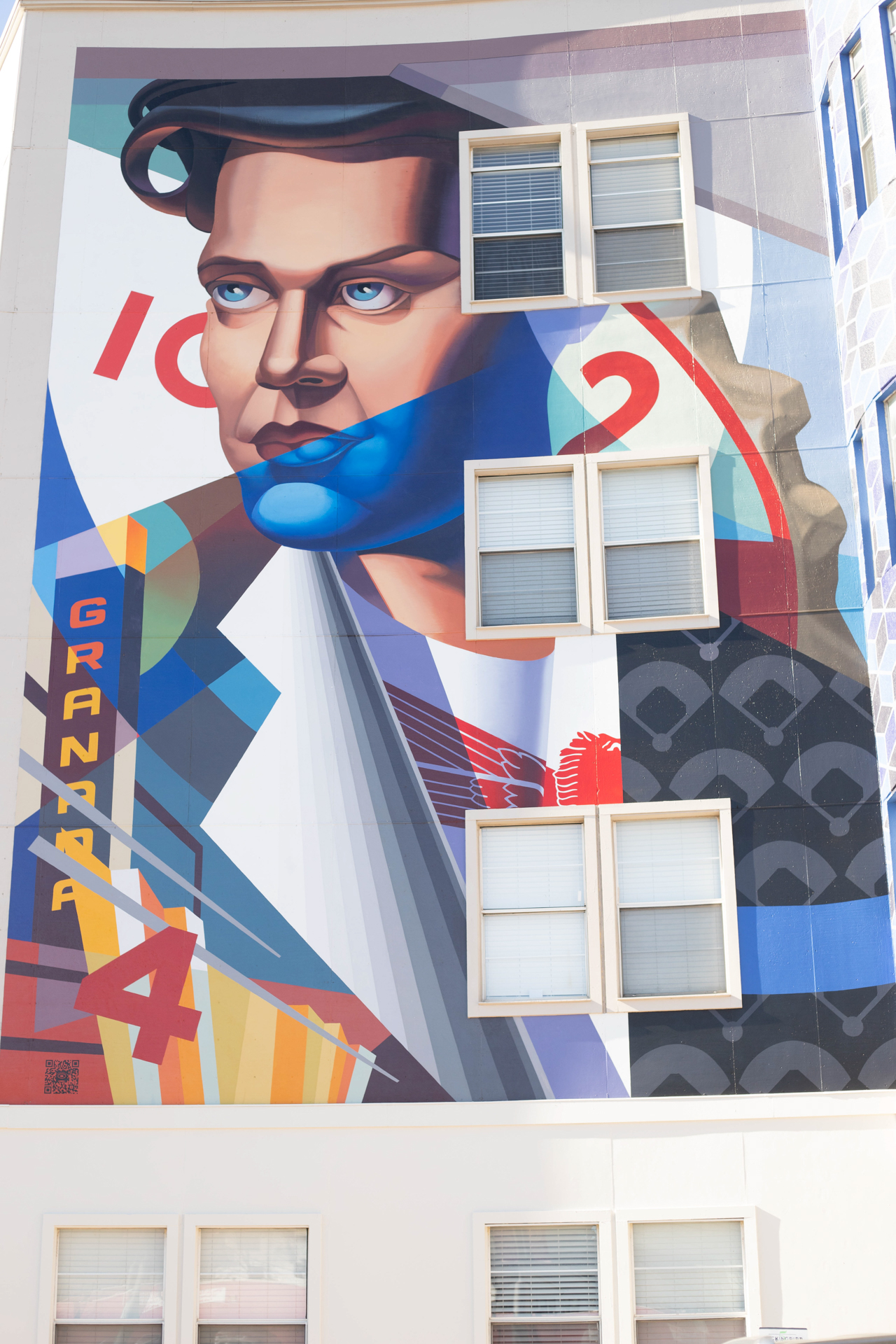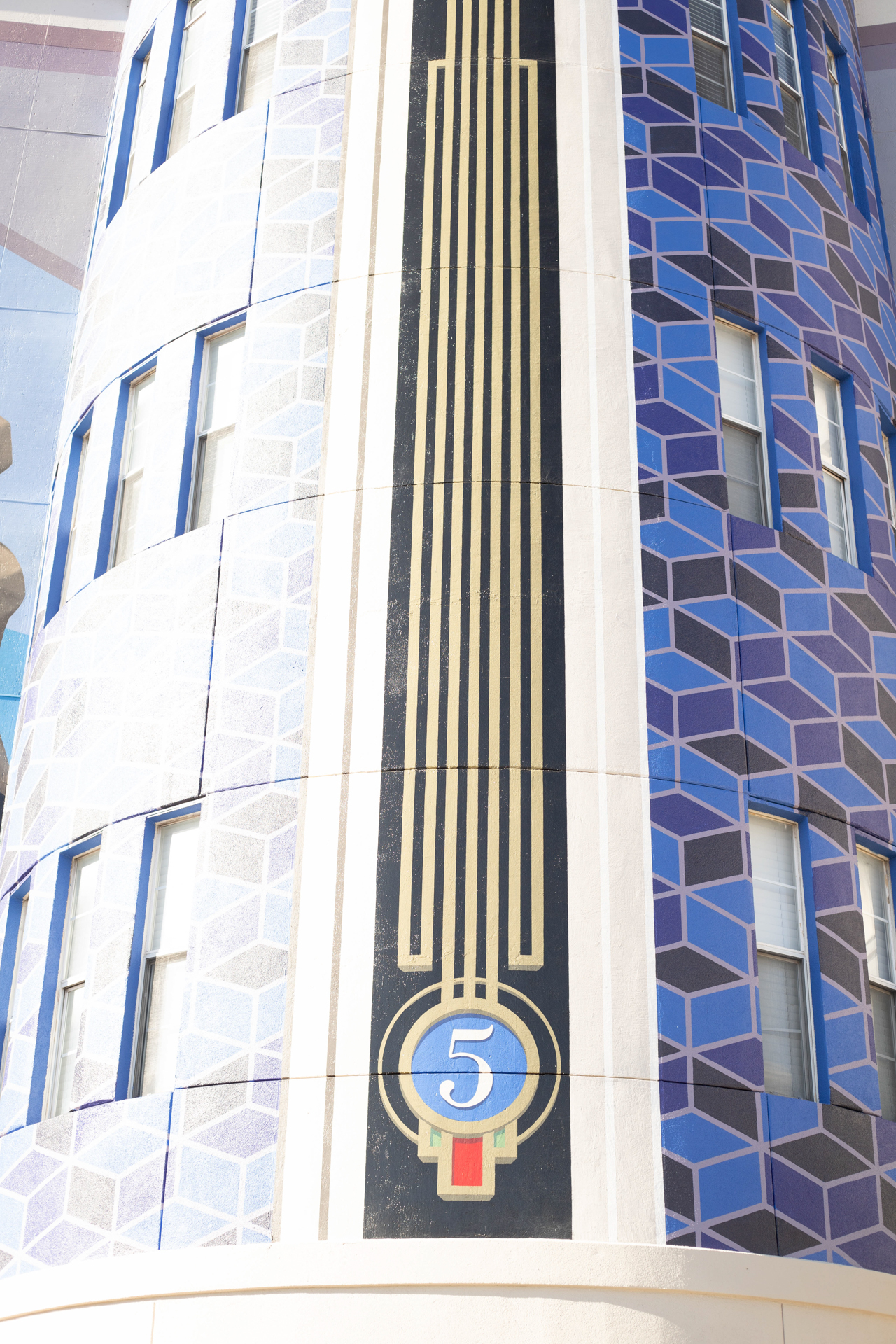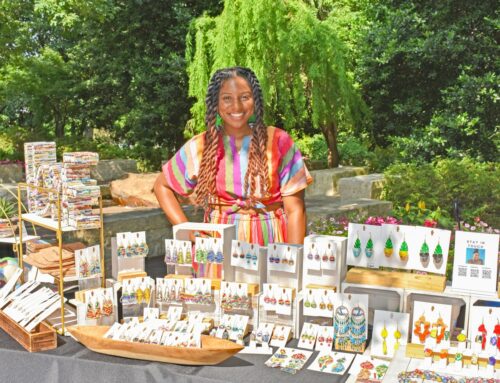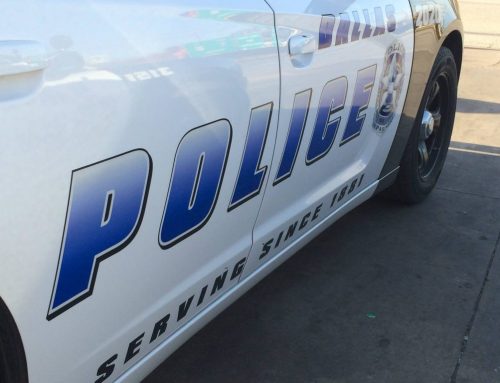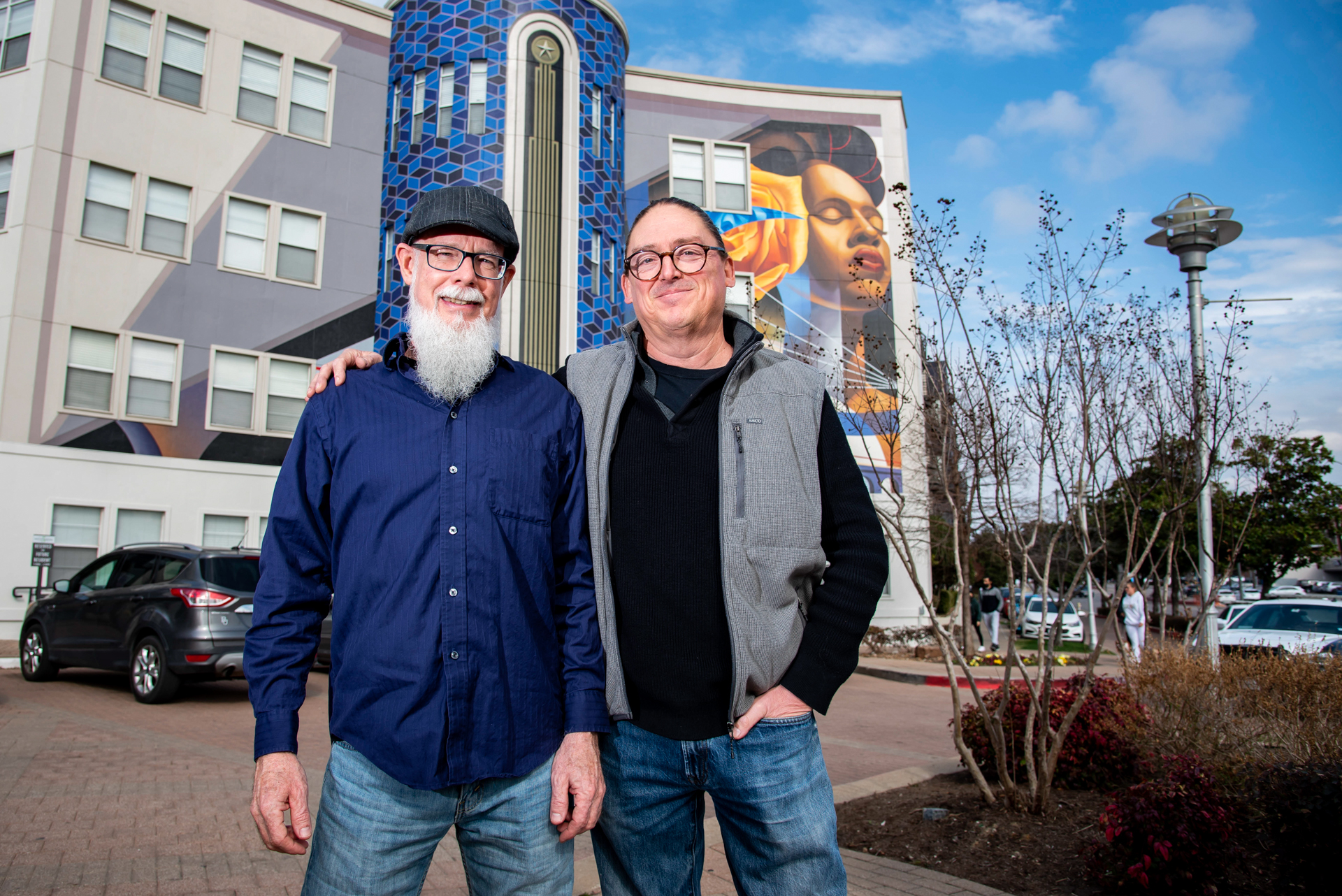
Photography by Emil Lippe.
Artist Jeff Garrison was on a job site when he received a call from neighborhood architect Paul Chapell.
“He called us, driving by it, in a panic. We were at the studio; we had no idea what was going on. He was just on the phone telling us: ‘They’re painting over your murals!’ I was like: ‘Come on.’ I just laughed and didn’t initially believe it.”
But Chapell was correct: The seven gigantic, iconic murals Garrison and Chris Arnold had painted on the exterior of the 5 Mockingbird apartment complex were being painted over by a construction crew. The colorful murals adorning the building, which is between Mockingbird Station and Kroger on the north side of Mockingbird Lane, were disappearing behind a solid wall of beige paint.
Arnold and Garrison recently celebrated the 30th anniversary of their company, Eyecon Studios. Five years have passed since the original murals disappeared, and five months have passed since the artists completed the creation of a smaller version of what was lost.
The new murals aren’t replicas of the previous ones, but they carry the same essence and theme of art deco, or what the artists like to call now, “contemporary deco.” The art is meant to represent Dallas culture, diversity and history, Garrison and Arnold say.
Do you recall how you initially felt when you realized the murals were disappearing?
Arnold: Chapell took this very personally, as he was the one who was responsible for this apartment being branded with paintings. At the time, I was thinking that if someone were to tell someone to come to 5 Mockingbird, people would have to be giving out the actual street address since nobody would know where to go. It was no longer going to be a landmark in Dallas. We were kind of the city’s navigational aides.
Garrison: We were just feeling the lines of grief at that point, where at first it’s disbelief, and then there was anger, disgust, sadness.
Arnold: Yeah, basically the seven stages of death.
Garrison: It basically came down to the final stage of acceptance. There was nothing we could do about it. It wasn’t our property anymore.
There was a request for proposals put out to restore the murals. How did you guys hear about it?
Arnold: The first time we did the original murals, which was a decade ago, the architects just tapped us directly since they wanted to work with us. Two ownerships later, the new owners didn’t exactly know who we were. SPI Advisory LLC , the new owners, knew a little bit about the original art, and they knew that they wanted the art back. So they just put out a request for qualifications out to the masses; it was just open to anybody. Another artist friend of ours saw an article in the Lakewood/East Dallas Advocate about the requests for artists. He called us and said, “Are you guys involved in this?” And we had no idea about it. So I had to call the new owners’ office and introduce ourselves and request the information that they were sending to artists. We told them that we would like to throw our hat in the ring and have a shot, but they weren’t guaranteeing us the job. They were just saying sure, we could just apply like everybody else.
Garrison: Yeah, they also had some other plans for some other areas they had talked about at one point, and they were trying to figure out if it was going to be the same artist group, or if they were going to bring in a bunch of different artists and somehow try to tie it all together.
Arnold: Which is really admirable of them, because they weren’t bound to do any of that work. They didn’t have to put any of the artwork back, and their point of view was basically they were giving a gift back to the city that was taken away from the community.
Describe the steps of how the current murals were painted over the beige coloring. Was it easy?
Garrison: You know, the deal we had with the ownership is that they were going to send somebody out to come power wash the surfaces so that the paint would properly adhere to it. So Chris came out to make sure that they had done their job, and he noticed that there’s this blue spot way up high. So he took a picture of it, and when he came back, we realized it looked like one of the colors from the original murals. Chris went back up there with a ladder and some duct tape to see if the new paint would properly adhere, and so he did the test … and it just peeled it right off to the original mural.
Arnold: So we went back to the current ownership, and said we weren’t going to spend the time doing it, and it wasn’t worth it since the new paint wasn’t going to stick. So they had to completely strip the whole front face of the building. They were really the heroes of this entire story, because they didn’t have to put art back on the building.
Photography by Jessica Turner.
What are the themes and messages in this new mural?
Garrison: We wanted it to be bold, to where you could actually see if you didn’t have time to slow down to discover all of the details. We wanted to make sure that the murals represented things that are important to the city as a whole, to the demographic of Lakewood and East Dallas as well.
Arnold: If you take a closer look at the bottle cap, you will see numerals 10, 2 and 4, which is meant to represent “Dr Pepper time.” Only veteran Dallasites would remember that. Artists through the centuries, they truly are the lens of the community. As artists, that’s our role. All the information gets synthesized through their eyes and put there, because these images reflect what’s going on right now. That is what these murals represent to us.
How are the murals different this time around compared to the original murals a decade ago?
Arnold: This time around, we only had two areas and murals to work on, so our scope was a bit more limited. Cultural diversity is really important in the community and as artists, our job is to reflect that. So in an effort to have some culture and mix it up, we wanted to have an African-American woman and an ambiguous-looking male figure. The most important thing from a design standpoint was that they wanted this to be in art deco nature with a modern flair. But to me, art deco is all about strength and stylized design, and that’s exactly what these two figures are. For the female figure, I wanted her to look powerful. I wanted someone to look at that and think strength, power and beauty before Black or white.
What’s the significance of the male figure?
Garrison: The male is cut with this dramatic blue. He’s got this dark hair, and we wanted him to be slightly ambiguous. He could be white, Hispanic or multi-ethnic. On the original murals, we had more of a chance to add African-American and white figures on there, different races and different people. But in this case, there was only space for two murals and figures we could work with.
Why is it that there’s only space for two murals this time around?
Garrison: It’s just mostly budgeting, cost-related.
What makes the new murals iconic?
Arnold: The fact that it’s art deco in nature and that is important to me because I am a Dallas native. I grew up going to the Dr Pepper plant, and I thought it was a very beautiful building. So the fact that they kept some art deco spirit in this property is a big thing. Secondly, it’s considered a Dallas landmark and a gift back to the community. It’s also nice to hear from people coming up to us and identifying the mural in some way that was personal to them. Everyone always has a story that starts out with, “Hey, when I was a kid,” and they basically take ownership of the mural, and that’s very rewarding to us.
Garrison: Yeah, that’s one of the more enjoyable aspects to this type of art is that it’s not in a gallery space, it’s not in a private residence, it’s not in some high-rise office building, it’s available to the public and everyone. Even if people weren’t living at 5 Mockingbird, they felt like it was so personal to them. When you’re up on these metal lifts painting and someone takes time to stop, slow down and take a break from looking at their phone and finally give us a thumbs-up, it made us feel so good to know that people were appreciating the murals that we were restoring again. There’s also a lot of traffic on Mockingbird, so I’m sure it was a good show for everyone to see the process unfold and play out.
What do you hope for people to take away from this new mural?
Arnold: I want them to slow down, smile, ask questions and reflect.
Garrison: And if they get a chance in their busy schedules, to pull in and look for some of the hidden objects in the art.
Do you think this mural will last for awhile?
Arnold: It’s possible. That’s the goal!

